Iowa, United States of America
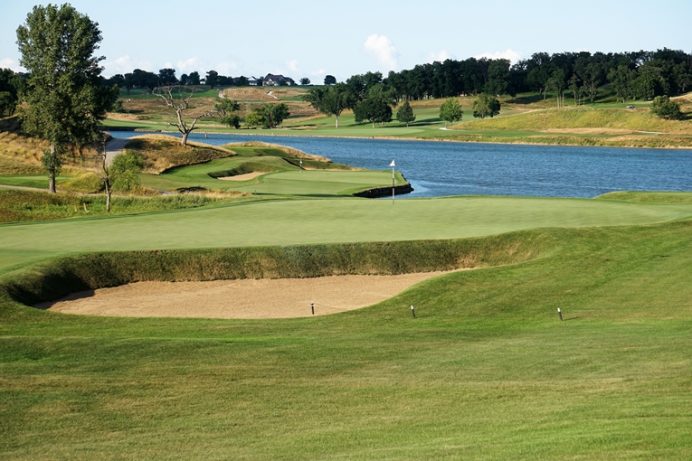
Welcome to golf in Iowa.
Golfers yearn for unique playing experiences. If they didn’t, why travel? Happily, the sport is adept at delivering that very thing. Given that each parcel of land is different, so too is each course. And, of course, the founding vision sets the tenor as well. American icons like Fownes and Crump acquired unique parcels and then set about constructing a course that reminds one of no other. Same happened in Iowa. Welcome to the Jensen family – The Harvester is their story.
An engineer by background and a developer by profession and an Iowan for life, Dickson Jensen began in the 1990s to muse over why his home state didn’t possess a course that competed with the best in the country. After all, Iowa enjoys more of the rollicking landforms found in Minnesota to the north than it does the flat farmland east in western Illinois. Therefore, Jensen thought it readily possible to marry his love of golf with building something special, something of which he, his wife and five sons would all be proud. Yet, the project needed to be financially successful, this wasn’t a Walter Mitty exercise. He watched a golf course and sub-division go up on the west side of Des Moines. Though a runaway commercial success, he realized that too many homes hindered his desire for a course to reach an elevated stature within the game.
As he poked around for land, he studied and read books on the subject of golf architecture. There seemed no inherent reason that a course couldn’t be built that embraced the design tenets from the Golden Age. The more he read, the more he became convinced that the best courses are found, not built. Sure, he would need an architect to pull the best features from the land but the die would be cast based on the quality of the land.
One day in 1997, he read about 180 acres for sale in Rhodes, Iowa, 45 minutes north of Des Moines. It was a former camp ground site and 60 of the 180 acres were comprised of Crab Tree Lake. Dotted with a variety of specimen oaks, the rolling property possessed dramatic qualities. It wasn’t hard to envision the lake offering both attractive backdrops and tense playing moments. Still, he would need more land for a clubhouse, range, and parking than the 120 acres.

Parcel # 1 featured the most water frontage along Crab Tree Lake.
His gut was right. Ultimately, that initial parcel only housed holes 13-18. Happily, things continued to fall his way. A second triangular parcel became available. Holes 10-12 are now found on it. Then, a third parcel of 160 acres came on the market from other farmers, Jessie and Ethel Wright. This block holds today’s clubhouse, cottages, parking, expansive practice area and holes 1-6. Last but not least was the fourth parcel, which was acquired from relatives of the family that created Crab Tree Lake in the 1950s.
As this was going on, Jensen started the process of selecting an architect. He reached out to the large firms of Nicklaus and Fazio but ultimately, he decided a one-on-one relationship with a boutique firm would be in his best interest. A born and raised Mid-Westerner, he wanted someone who spoke the same pragmatic language. He settled on two prime candidates, Dick Nugent in Chicago and Keith Foster in St. Louis. He spent a wonderful time with Nugent at The Dunes Club, the 9 holer built by Nugent for Mike Keiser near the shores of Lake Michigan in 1993. They got along great but eventually, Jensen selected Foster after touring several of his works in Texas and Missouri. The Quarry outside of San Antonio especially caught Jensen’s eye for originality. It struck all the right chords of being different, interesting and creative yet still true to a sense of place. In Foster, Jensen believed he had found the right up-and-comer.
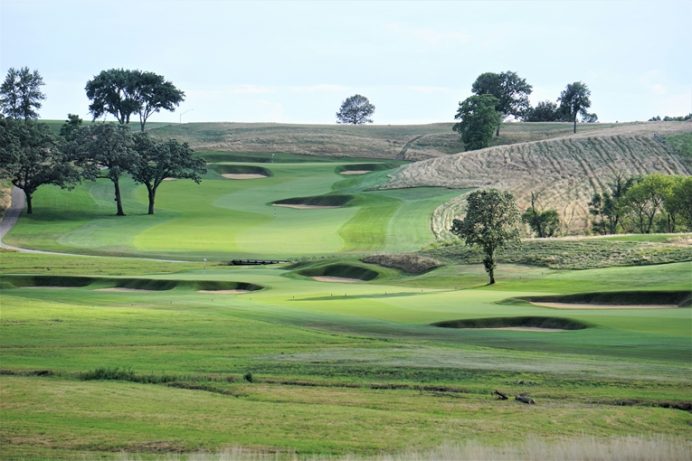
Parcel #2 yielded three holes including 11 in the foreground and 12 going up the hill.

Parcel #3 yielded the 6th hole in the foreground.
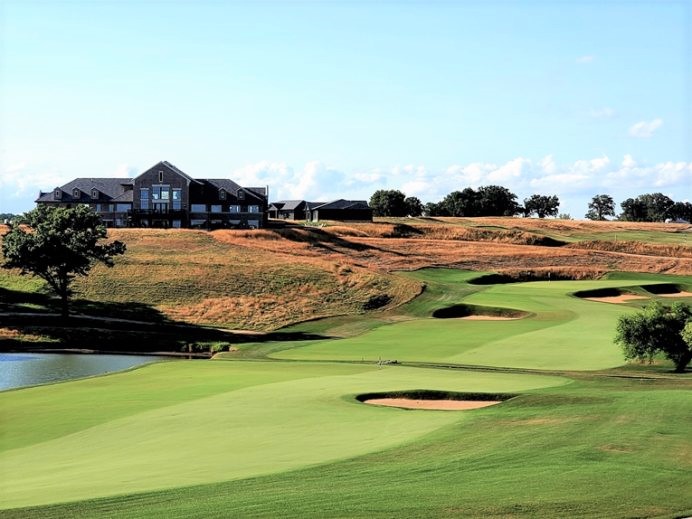
Parcel #4 yielded the brawny 9th.
With the four parcels secured, Foster commenced work in 1998 and this public course opened in 2000 to rave reviews. Some sixteen years later, Tom Doak gave it a 7 in The Confidential Guide, high praise indeed, noting “From the the fine par 5 6th to the lovely downhill 14th, there are good holes of every length.” The typical green fee was $70 -$80 and with 22,000 to 24,000 rounds per year, life was good. Of course, owning a golf course comes with ups and downs outside your control. 9/11 happened early on, which hindered travel, and the economic demise in 2008 and 2009 saw the number of rounds diminish to 6,000 per year.
By 2015, the golf operations had become a bit of a grind. The infrequent golfer wasn’t always respectful to what had been created. Ball marks, unkempt bunkers, boorish behavior, things that just shouldn’t happen, occurred on a daily basis. To the Jensens, opening your creation to people who routinely exhibited poor behavior proved wearisome. For sure, plenty of people were great guests and the question became how to attract such players, those who would care for the course and look after it.
At the urging of his family, Jensen elected to take The Harvester private in 2017. He contacted Foster again, who candidly said two things. One, he was a better architect then than in the late 1990s and two, he didn’t see much room for improvement in the greens themselves. However, he saw opportunities to enhance the golf tee to green, especially by better connecting the tees to the prior green. Look no farther than the first for example. As a public course, he placed the tees away from the practice putting green, down by the creek. As a private club destined to have fewer than 60 rounds a day, he connected – literally – the first tee to the practice putting green. Talk about a seamless start! Same applies back left of the eleventh green where the back marker is nothing more than an extension of the putting surface.
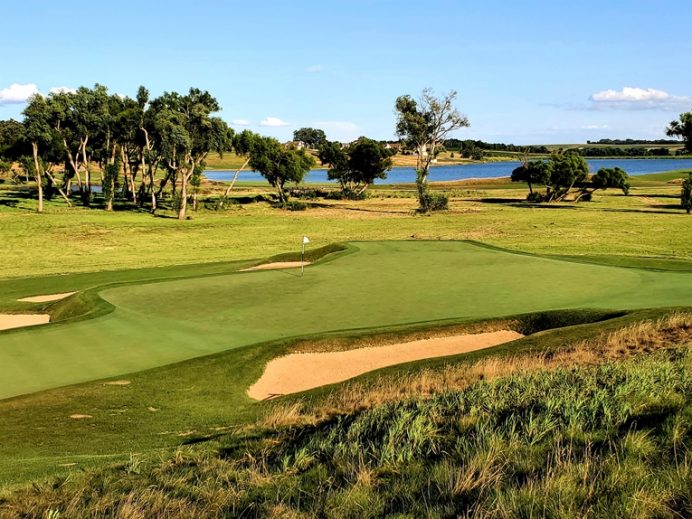
The rear of the 11th green serves as the back tee for 12.
Foster’s 2017 marching orders were to add classic design features to make the course as great as he possibly could. If he did, Jensen was confident that quality people who appreciated the effort would join. The course closed in the fall and reopened in the summer of 2019. Apart from enhancing the walk by tighter green to tee connections, what else was modified from the original design? A variety of things. Take a look at the photograph below looking back down the second. Previously, three bunkers divided the two alternate fairways, now one Church Pew bunker installation does.

At the fifth and sixth, mounding was removed that separated the two playing corridors and now they enjoy a shared fairway, a feature that emphasizes the property’s expansive nature. At the seventh, the fairway was lifted and a cart path was re-routed, greatly enhancing both the playing qualities and visuals of that hole. Forward, top shot bunkers were installed at ten. At the eleventh, a tee was installed left of the tenth green that requires a 260 yard (!) diagonal carry over wetlands. The sixteenth fairway was massaged – instead of being a harsh break, one long continuous fairway was created with a speed slot that can send tee balls running for 50 yards.
In sum, many components were either added or enhanced. As Foster predicted at the outset, not much was required to the greens. A front thumb print was added at the short 14th but that’s about it. The greens, many with false fronts, had long been a staple to The Harvester’s challenge. The course’s Green Keeper since inception, Joel Randall, has them dialed in for firmness and speed on a daily basis. In fact, in 2020, these were the firmest, fast greens that the author saw. They allow the flashed up sides of some of the putting surfaces (e.g. the left of the first green, the amphitheater like fifteenth green) to act as the friend of the player. Conversely, the false fronts on several of the elevated targets like the second, fifth and twelfth greens can be maddening.
Nice touches abound. Specimen oaks add to the round as do the long views across the lake. Any time a green backs onto the lake, you are guaranteed to have a clean backdrop with no fussy mounds to distract the eye. Heck, even the rest houses are tastefully done and add to overall ambiance.
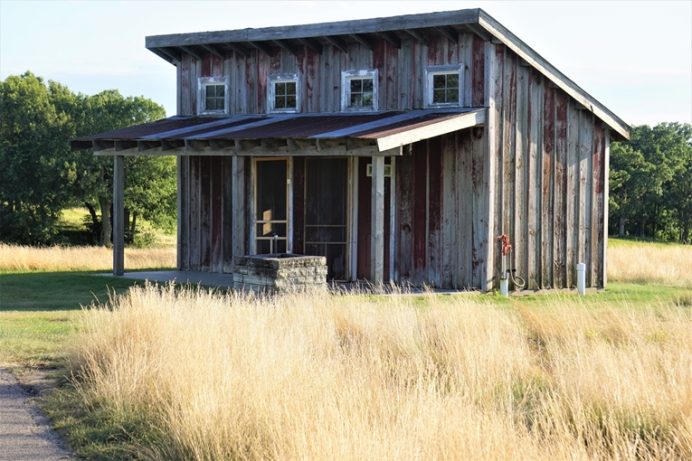
A rest stop between 5 and 6.
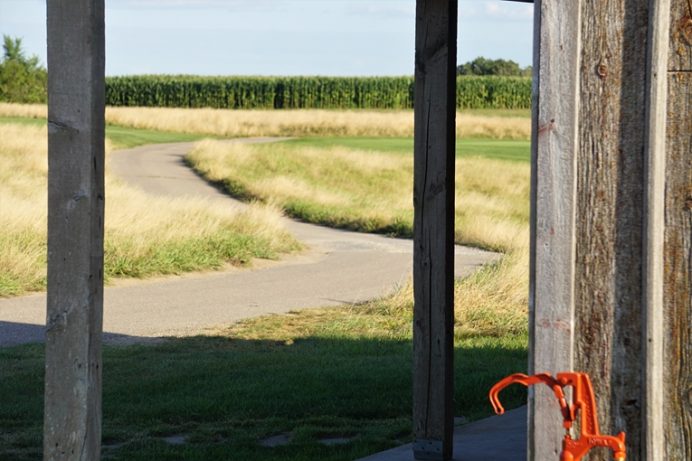
A cornfield greets the player as he emerges and heads to the 6th tee.
Foster’s renovation took the course from being very good to something remarkable. Layer on immaculate playing surfaces and the solitude that comes from being removed from a population center and the foundation is in place to have a special experience every time you tee it up. Best yet, since it is run by the Jensen family, there are no committee meetings of the sort that derail otherwise well-intentioned club boards across the country. There are no tennis or pool members clamoring for action. The focus is solely on the golf – and it shows as we see below.
Holes to Note
Third hole, 200/150 yards; Jessie and Ethel Wright’s cows are gone now but this pond was their watering spot. Now, it is the first of seven (!) holes where water brushes to within a few yards of either the fairway or the green. In a couple of instances, the water (e.g. the eighth and fourteenth) acts as a bonny backdrop with only the over zealous tee ball finding aqua. Not here, though for the good player, it is the bold ridge that protrudes from the left that causes the most consternation. A forward hole location is problematic for the obvious reason of the fronting water but also because the first 2/3 of the green slopes tilts dramatically toward the front. Can the player draw a ball back toward the hole? Meanwhile, the hole’s ask significantly changes when the hole is placed back right, as we see below.
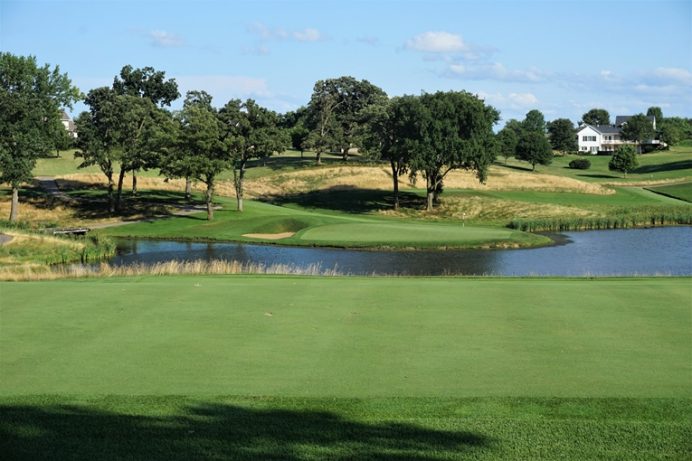
Note the tie in from the hillside through the back middle of the putting surface. Given today’s back right hole location, can the player flatten the trajectory of his tee ball, have it land in the middle of the green, roll up the crest, then trickle down and right toward the hole? It is a very rewarding shot to execute properly.
Fourth hole, 595/545 yards; Foster did an exceptional job of incorporating the land forms into this hole not once but twice. Off the tee, a huge dip in the fairway can propel a player’s tee ball forward an additional ~50 yards, which brings the green within reach. The rub becomes the second. Foster wisely left several specimen oaks some 70 yards short of the green and their canopy is a definite consideration. Still, the left to right sloping terrain can very much be the golfer’s friend. As seen below, can the player manufacture a bullet three wood low under the oak and toward the left edge of the green? Such is the daily presentation that any ball that lands 30 or 40 yards short with heat will find the putting surface. Just how firm are these fairways? The author – unintentionally – faded his three wood approach a bit too much. It hit left of the tree and took off. The fairway extends well right of the photograph below and his caddie dutifully searched for his ball in that general area. Turns out the ball made it to the greenside bunker but the point of the story is rarely do Americans encounter playing surfaces whereby they might be off 40 yards in their search! The job that Randall and his crew dovetails perfectly with Foster’s architecture to create one of the Midwest’s most compelling playing experiences.
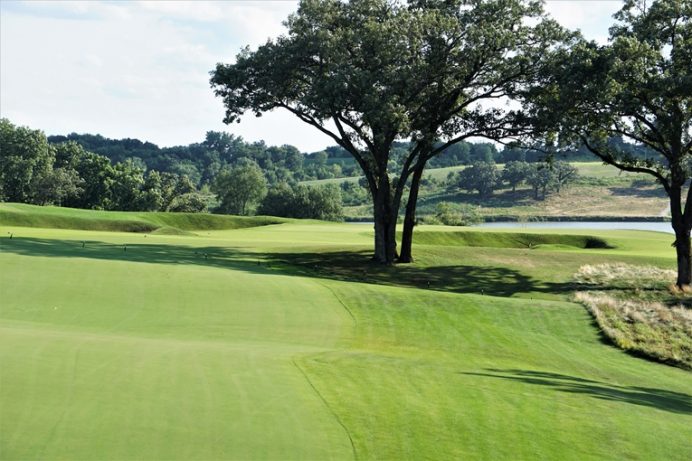
The foreground hints at the fairway’s rambunctious nature. Meanwhile, up ahead, the left to right tilt of the land is the dominant playing feature once the golfer skirts past the oak trees.
Fifth hole, 365/340 yards; The sixth and sixteenth holes play strikingly downhill and lend the course great theatrics. No surprise to learn that to get to those elevated tees, the two previous holes (i.e. the fifth and fifteenth) both play significantly uphill. Some architects shy away from uphill holes, preferring to transport the player uphill between the green and the tee. Not Foster. Indeed, several of the day’s most memorable moments often come on the five holes that climb more than 30 feet from tee to green, including this one.
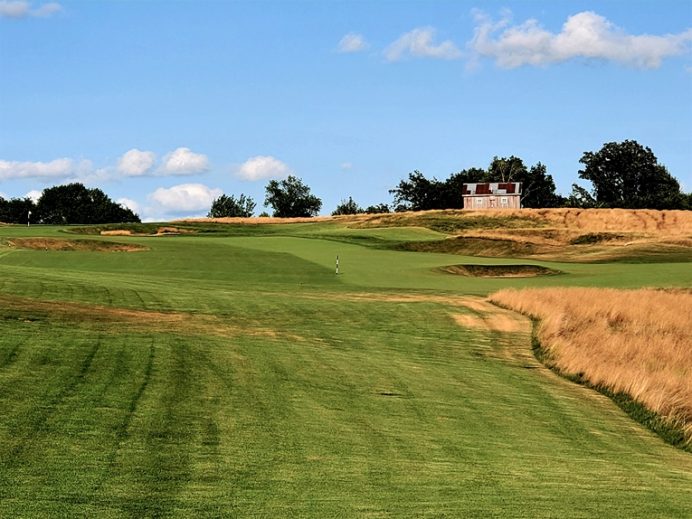
Don’t be fooled by the shared fairway right with the sixth or let that central bunker give you pause for concern. Aim long left and …
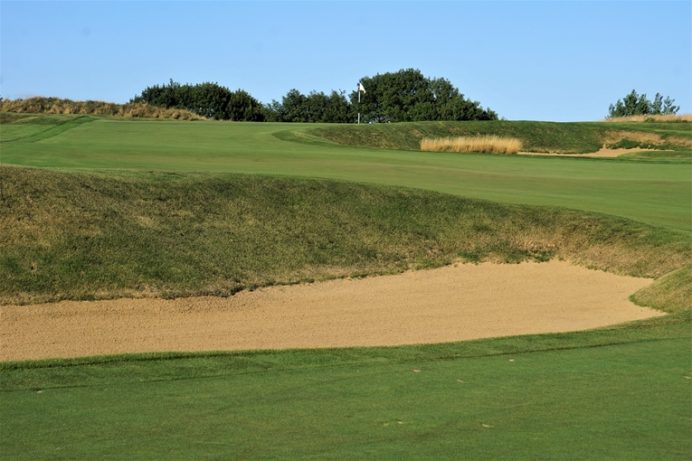
… enjoy this 100 yard approach, though beware of the green’s false front, as the sight of a well struck approach ‘de-greening’ and running 10 yards back into the fairway is demoralizing.
Sixth hole, 560/535 yards; A downhill par 5 that plays a manageable distance sounds like easy pickings for today’s tiger. Yet, this one has plenty of defense and readily wrecks the start of many a good round. The tee ball seems expansive, thanks in part to the shared fairway with the fifth but in reality, it bottlenecks down 300 yards from the tee where a creek emerges that tracks along the right of the fairway before feeding into the pond that fronts the green. Even after a well struck drive, the best case scenario is that the player is left with a tricky downhill stance from which it is simplicity itself to hit one slightly fat. In an effort to avoid a certain watery death, the golfer can also catch it thin, in which case the ball won’t stay on the green, which is wider than it is deep. One of architecture’s duties is to identify the best ball striker – and this hole does that with aplomb. And the person who best appreciates how hard it is to gain height from a down slope to hold this green in two? Your opponent.
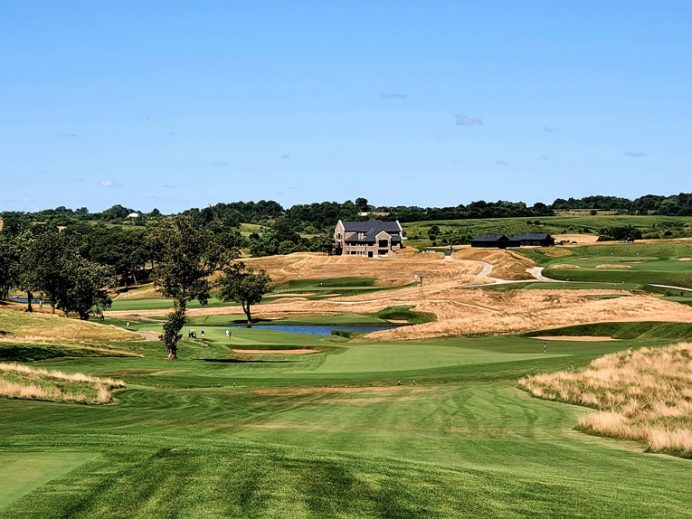
This view, this hole is exactly why you travel to the Heartlands.
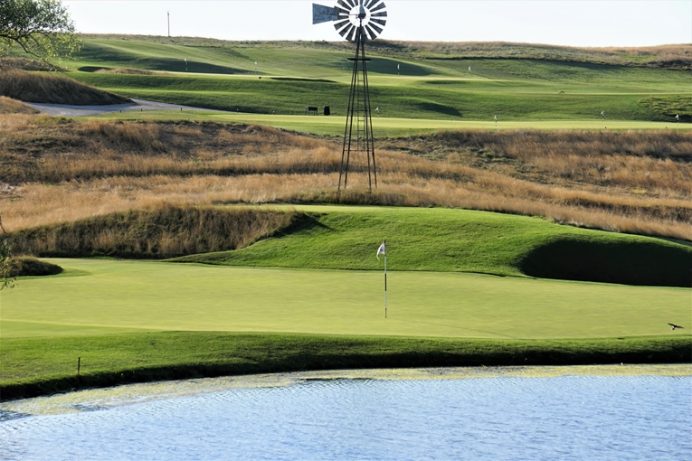
Looking across the pond that fronts the 6th green, with the practice area in the distance.
Seventh hole, 390/360 yards; Foster adheres throughout this design to a ‘less is more’ approach. If one bunker will suffice, so be it. Take this hole. The high hillside left works in concert with a solitary bunker right to provide the strategy off the tee. Could he have put multiple bunkers along the right? Yes, but to what purpose? Why clutter up a handsome landscape with man-made features? Let the land and its movement be the star. Foster’s ‘clean’ approach is again highlighted at the green, which is skyline in nature with one fescue covered mound peeping out in the distance. Just as they are on the uphill approaches at the second, fifth, twelfth and fifteenth, the locals are leery of this green’s false front. The playing tension between not wanting to be above the hole but still clearing the false front is exquisitely enduring.
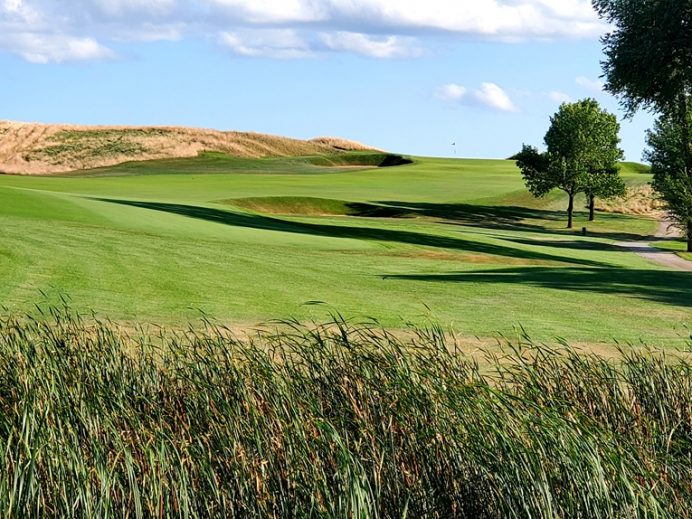
A cart path once crossed this fairway and finished left of the green. No more.
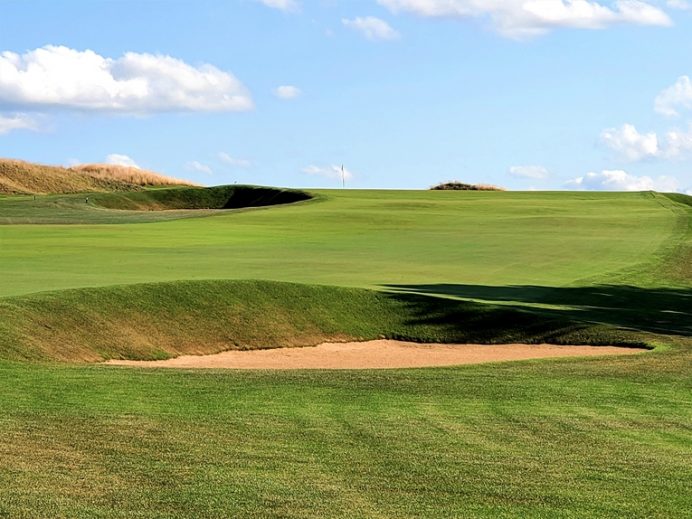
This solitary bunker is more than ample to set the challenge from the tee.
Eighth hole, 235/170 yards; Forget the green, this one shotter is all about the gap between the two greenside bunkers. That’s the landing zone, given the firmness of the green and once the ball reaches the putting surface, all it wants to do is move right. Given that Randall routinely provides green speeds in excess of 12, the hole location seen below is actually one of the easier ones as the ball obligingly gravitates to that lower right portion. The toughest hole location is anywhere high left.

A neat aspect to The Harvester is it employs a one tee marker system, which reduces clutter and yields a streamlined appearance. Here at the 8th, when the hole is far left, the player should avail himself of the opportunity to tee it up on the extreme right side.
Ninth hole, 435/415 yards; A grand hole in every respect to the point where the author contends it is one of America’s best holes of which most people are unaware. Crab Tree Lake borders the fairway left for the first 335 yards with the bunkering scheme near the green rewarding the player willing to play down the more dangerous left side. A newly added right fairway bunker tightens the challenge. When the course opened as a public facility in 2000, it didn’t exist – the hole was plenty hard already. When the Jensen family took it private, Foster place it in such a manner that the entire bunker occupies space that was previously fairway. Over his three decades as an architect, Foster has polished his ability and strengthened his resolve to place hazards where golfers wish they weren’t, which is to say, in the line of play!
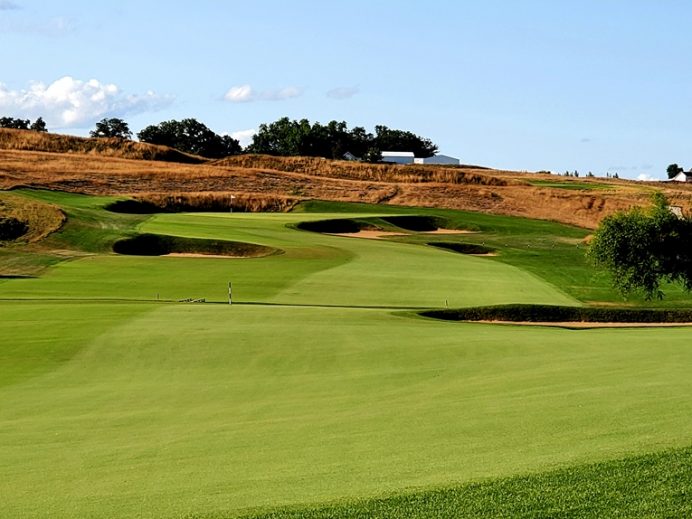
What an amphitheater – The author would love to see thousands of spectators ringing the 9th green for an event. Both the club and state would make for wonderful hosts.
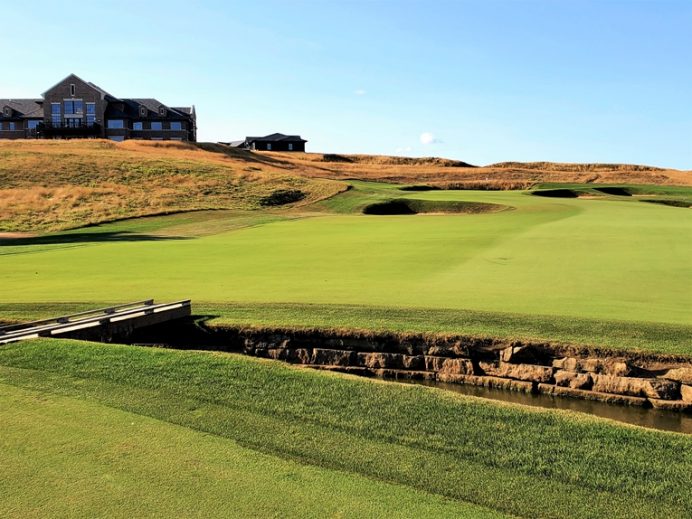
A burn crosses 125 yards prior to front edge of the green.
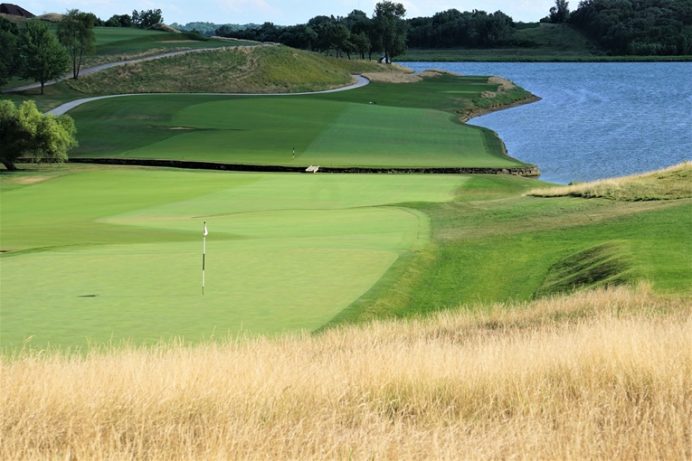
A view back down the 9th shows why it is the course’s most intimidating tee shot. The green’s tilt is also evident and can yield 40 foot putts that break 20 feet – yikes!
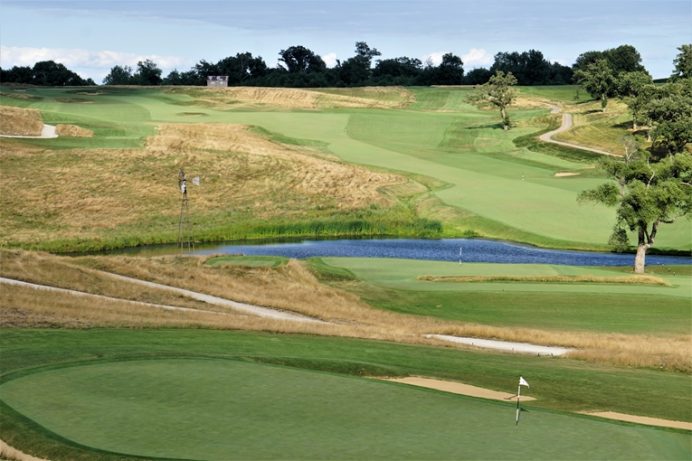
Before heading to the back nine, one last look across the 9th green and up to the shared fairways of the 5th and 6th.
Tenth hole, 450/430 yards; After holing out at the ninth, the golfer stops in the clubhouse for a refreshment before heading over to a different part of the property. Given the appeal of the front, trepidation exists, can the course sustain the same level of playing excitement? Shockingly, any hint of a letdown fails to materialize.
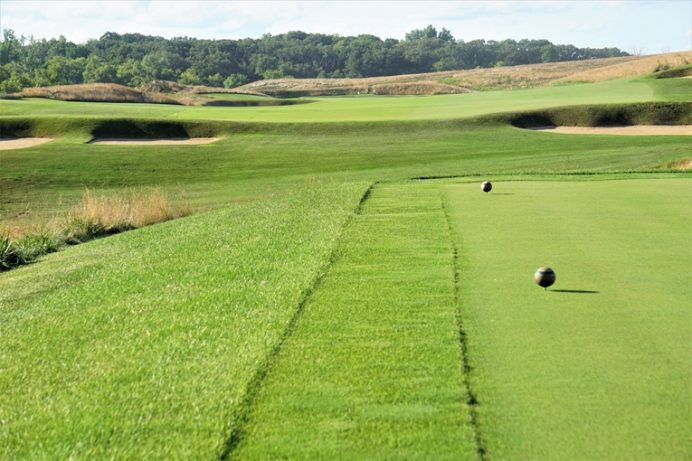
Note the old-fashioned ‘top shot’ bunkers, only 150 yards from the tee. Strategically, they may be unimportant but imagine the hole without them and one concludes that aesthetically, they play a fine role.

This bunker was added as part of the 2018 revamp. The real kicker though is how the crest of the hill blocks a full view of the green and its false front.
Eleventh hole, 440/360 yards; From the new back markers, the tee ball is a full bloodied, 260 yard diagonal carry over lowlands. For mortals, the hole is more humane, though it still represents something that the golfer has yet to encounter: a flat hole! Foster’s customary steep, grass faced bunkers lend the hole a 3-D quality and their intelligent placement keeps the golfer on his toes.
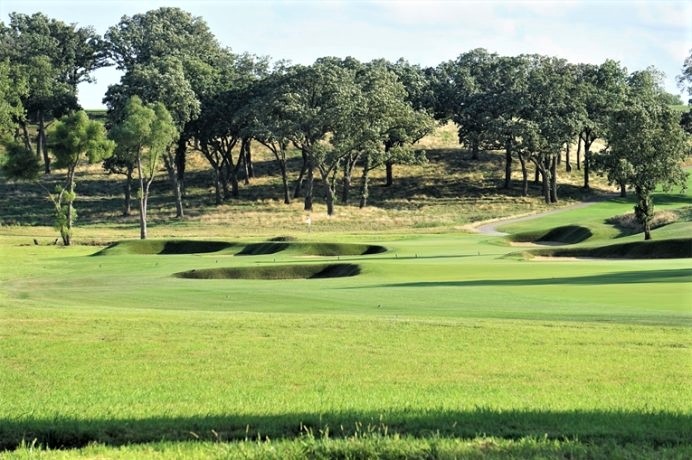
Upon standing on this tee for the first time, the author was instantly reminded of Australia’s bushland, so attractive is the backdrop to the 11th. Meanwhile, his opponent had memories stirred of the Serengeti in Africa. Both positive reactions weren’t by accident. Great effort was spent over the 2019/2020 winter to clear away the brush to create/reveal that very image.
Twelfth hole, 420/370 yards; Jensen’s thesis that the land determines the course is born out in the three stretch from eleven to thirteen. The flat eleventh fairway is followed by this playing corridor in its own 80 yard wide valley that ascends from tee to green. What comes next at thirteen? A hole routed along a spine with fall-offs on either side. What more variety can the golfer possibly ask for?! Foster’s routing nailed the opportunity that Jensen created by his purchase of the four tracts of land. Courses on more mundane property simply can’t compete with the different asks posed during a round here. As with the other uphill holes, the green can be a terror.
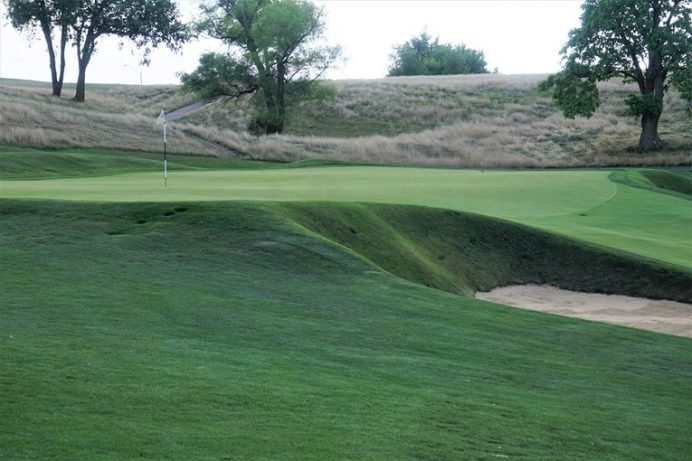
Beware the false fronts at The Harvester! Randall’s firm conditions prey on the golfer’s mind – to carry too far past the false front is to invite a swift downhill putt but to come up short is no good either.
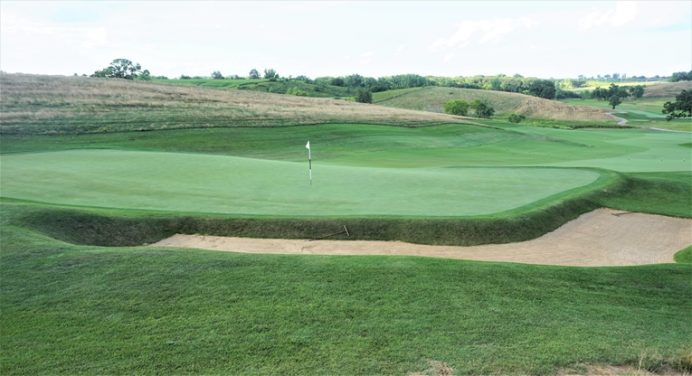
As seen from behind, the squared off, L shape bunker that was added in 2018 is the sort one expects to find on a course 100 years older.
Thirteenth hole, 420/340 yards; A tightrope act is called for as the domed fairway and green are the high spots with the hole otherwise giving way both left and right. A wayward drive left leaves an approach blocked by trees while one flared right can really become a mess, if not a lost ball. It is a very fine position hole for the 6 handicap, assuming he is smart enough to leave the driver in the bag. Meanwhile, played from 340 yards, it can be a real hand-grenade for the tiger – does he rip driver and try and reach the putting surface that is open front left or lay back? So good are the hole’s natural defenses that the author actually wonders about the merit of the back marker, preferring the conundrums posed at the risk/reward drivable length. Given how the green essentially sticks out on a peninsula, well elevated from its surrounds, one might think long views abound. However, a series of gnarled oak trees frame the green. They are so character-laden and distinctive that to remove them would be a mistake, especially as the course already enjoys so many sweeping views.
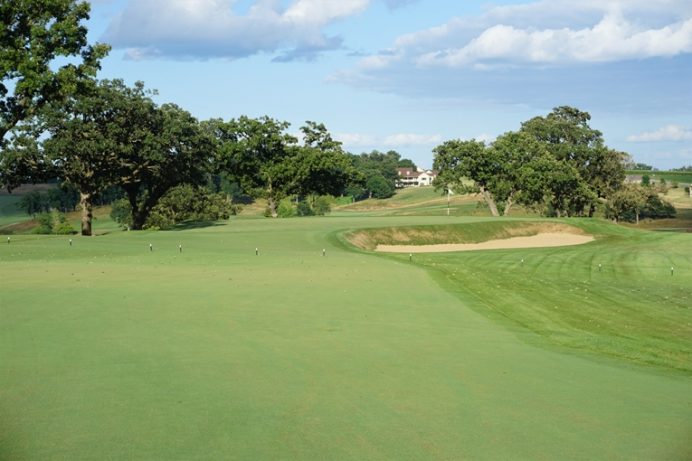
A prudently placed layup off the tee leaves this pitch to the green and diffuses the possibility of a double – or, conversely, an eagle.
Fourteenth hole, 180/145 yards; Classic design elements abound at The Harvester and no fan of golf course architecture will stand on this tee and not be reminded of the Macdonald school of architecture and its famous template Short hole. It now comes complete with a ‘thumbprint’ or ‘bath tub’ feature front right. Importantly, it possesses something that enhances all Short holes, namely marked exposure to wind. In this case, it glides uninterrupted across the 60 acre lake and the player either has to judge the effect of hoisting a short iron up into the wind or better yet, demonstrate trajectory control. Think about the backdrops of the prior few holes: the hillside at eleven, the twelfth cocooned in its own valley, the thirteenth framed by the oaks and now this one with the green and flag silhouetted against the lake. Such diversity of backdrops immensely adds to the game’s appeal here.
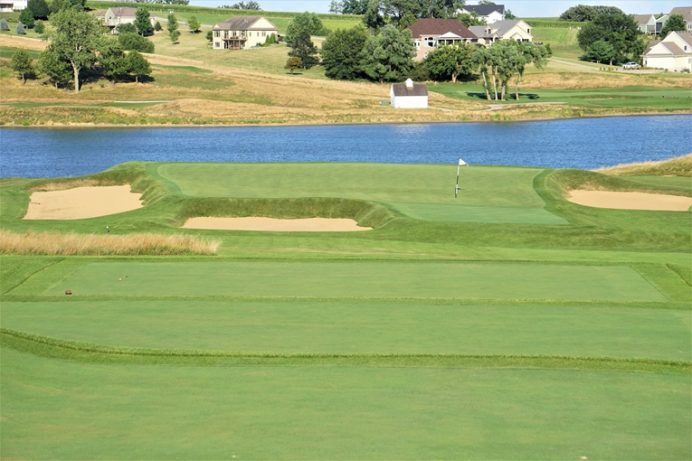
Today’s location is the hole-in-one position, as there are several ways to see a tee ball disappear.
Fifteenth hole, 650/550 yards; Herbert Warren Wind once wrote of 16 at Royal Dornoch that it was the type of hole that would appear in his nightmare as it went up and up with no end in sight. Such could have applied here as it could easily have been a long, dreary trudge uphill. After all, it is the course’s lengthiest hole with each shot progressively climbing uphill. So what does Foster do? First he builds his version of a Hell’s Half-Acre some 200 yards from the green. The golfer needs to find the fairway off the tee to successfully clear this minefield of bunkers. Having done that, the task isn’t complete because the green is one of the course’s most heavily contoured.
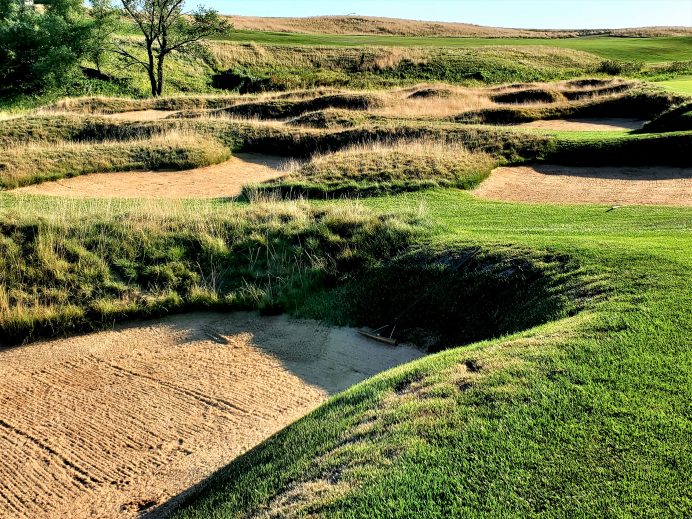
Getting past this cluster of bunkers in two is of paramount importance but …

…plenty of work remains ahead at the green. Its sides are shaved up, giving it a semi-punchbowl flair but the green’s tilt follows that of the land, which means any putt from above the hole is full of strive.
Sixteenth hole, 520/445 yards; A thriller, this hole was a prime beneficiary of the 2018 work as its tee placement was brought lower and left than previously. Additionally, at the time, golfers needed to lay up off the tee to stay short of a gulch before then hitting a hybrid to the green. Now, the fairway tumbles downhill uninterrupted. As at the fourth, the golfer stands a chance of getting a huge turbo-kick forward if he play his tee shot just right. The notion of a 300 yard tee shot rarely exists for a 6 handicap golfer but it does several times here, namely at four, six and here. Such potential, one-off joy exists on fast running fescue fairways in the United Kingdom; to find it available in Iowa on bent fairways is a revelation.
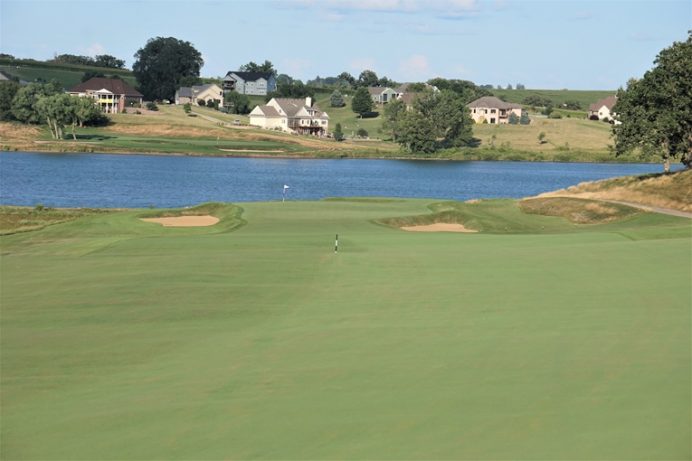
The day’s back left hole location takes conviction to chase after and is made all the more appealing by the lack of framing.
Seventeenth hole, 190/155 yards; The finishing pair provide equal measures of excitement and dread. Both are water strewn and the water is on the right which is more problematic the higher one’s handicap. All of the day’s good work can come undone, so the golfer needs to stay calm and golf on. The ‘miss’ obviously needs to be left but that’s the rub – just how far left and where? Neither of the two back bunkers are particularly appealing, as they leave the golfer a splash shot toward the lake. A tee ball short left of the putting surface is fine as long as it doesn’t turn into short right. Can the golfer stay committed to his shot at the top of his swing? The hole is full of questions, and only multi-rounds will provide satisfactory answers. To the author, that’s a mark of design greatness, which this hole achieves.
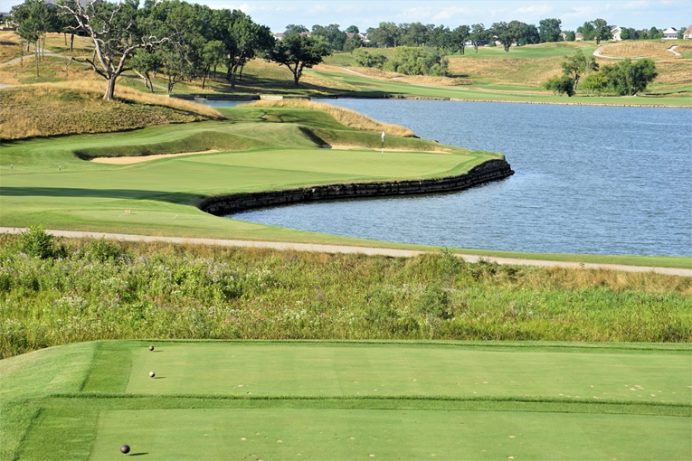
What a nervy shot, especially as the penultimate hole. To date on the back, water has only served as the backdrop at 14 and 16 but that changes right here.
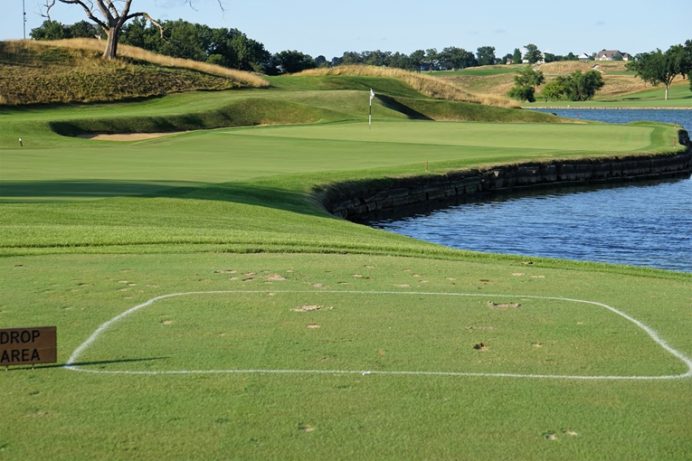
Hopefully, the golfer simply walks past the dropping zone.
Eighteenth hole, 560/555 yards; In addition to the eleventh, this is the only other hole that can be construed as flat; What a roller-coaster ride it has been! The hole button hooks around Crab Tree Lake, meaning that drive of ~250 yards along the right leaves an approach on the direct line to the flag of only ~225 yards. The scorecard measures it as a three shotter but as a half par, risk/reward finisher, this hole provides all the drama one could ever wish.

The green is at the base of the hill with all the trees. Does the golfer dare take a crack at it or should he lay up well to the left?
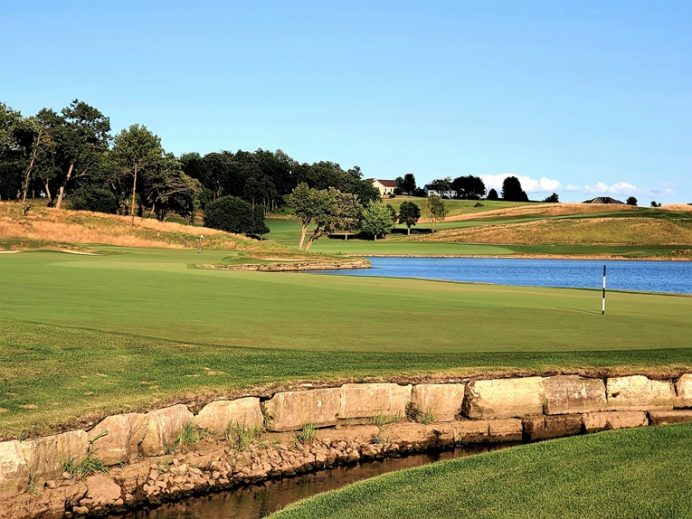
Played in a conventional three shot manner, the golfer needs to get past this burn in two and then wedge on.
Having toured the course, several things stand out. First, the absence of a weak or indifferent hole. Second, superior green keeping practices are exhibited throughout, from mow lines to the firmness of the playing surfaces. Third, there are standout holes hugely capable – indeed likely – of producing one-off, thrilling events that will stick in the golfer’s memory bank. Wrap up those attributes in the farm-like setting and you have a course of great distinction. More specifically, you have a course that is unique, that doesn’t remind one of another course elsewhere. Indeed, it is hard to stereotype exactly what kind of course it is. Parkland is inaccurate, it plays more like a links but clearly isn’t – how to describe it? One suggestion is to call it a farmland course, which accurately conveys its rural appeal.
Some courses like Pinehurst No. 2 and Sand Hills provide a homogeneous playing experience with their holes all cut from the same fabric. Other courses like Cape Breton Highlands and Bandon Trails take the golfer on a meandering walk through different pockets of property. Clearly, The Harvester falls in the second category, which came as a great surprise to the author. Foster’s use of the tumbling land juxtaposed along the 60 acre lake create a host of indelible moments.
In the same decade that the Jensen family enhanced their course, Ron Forse was working at Davenport Country Club to help restore C.H. Alison’s features to that design and Ron Prichard was at Cedar Rapids, polishing that Donald Ross gem to near perfection. Add in The Harvester and you have a triumvirate of excellent designs that would make any state proud. It has been 25 years since Jensen mused what it would take in his lifetime to bring world class golf to his home state. Now he has his answers.

With cottages on site, The Harvester is a grand place to wake up and start your day.
The End





![The Park, West Palm (Lit 9) [2023]](https://golfclubatlas.com/wp-content/uploads/2024/12/IMG_7092-2-scaled-500x383.jpg)


